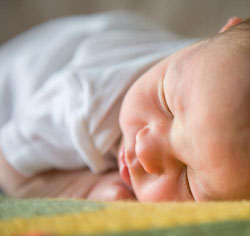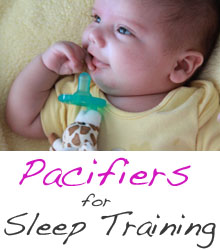 The season of change is upon us, and with it are a number of factors that might affect your baby’s sleep habits. In the United States we have daylight savings changes, which move the clock forward in springtime and backward in fall. Gaining an extra hour this fall seems like a great idea, right?
The season of change is upon us, and with it are a number of factors that might affect your baby’s sleep habits. In the United States we have daylight savings changes, which move the clock forward in springtime and backward in fall. Gaining an extra hour this fall seems like a great idea, right?
Until you consider the fact that circadian rhythms have a major impact on sleeping patterns, which might have your little ones waking up an hour earlier in the morning. Ouch! This article covers some of the seasonal changes in fall and winter, and how you can use them to help establish or continue healthy baby sleep habits.
Daylight Savings and Baby Bedtime
For me, the daylight savings time change in fall is a scary thing.
Essentially it means that sunrise will come an hour earlier, and so will the songs of the despicable birds that congregate outside of our house. Both sunlight and natural noise conspire to wake my boys in the morning. We combat this by using room-darkening shades with heavy curtains, and providing white noise in the nursery with a crib soother or sound machine.
Daylight savings is also an excuse to practice one of the most powerful techniques in baby sleep training: the early bedtime technique (EBT for short). The days are already getting shorter, so it’s a natural fit. The EBT will surprise you with how well it works in this transition period. Start adjusting for it now, so it’s not a shock when the clocks roll back.
We try to put our boys to bed about an hour after dinner, which means we finish eating, play for half an hour, and then start getting ready. Dinner is the kickoff event for our nightly bedtime routine. Ever since the boys started eating solid food, we’ve focused on getting them a good nourishing dinner to help them sleep longer without waking up hungry.
Dressing Baby for Colder Weather
So long as you address it, the colder weather is on your side when it comes to baby sleep training. It’s an opportunity to put your baby into cozy long-sleeve pajamas and a swaddle blanket or baby sleep sack. These have a few advantages:
- Keeping your baby warm overnight in case the temperature fluctuates
- Providing the touch sensation of something warm and soft against their skin
- In the case of swaddlers and sleep sacks, keeping baby from rolling around too much and waking up with a leg stuck in the crib’s bars.
The soothing white noise of central heating is a plus as well; it’s hard to imagine that a soft flow of warm air into the nursery would have anything but a positive effect.
Indoor Baby Activities and Exercise
One thing that sucks about the changing weather is that it keeps you inside. Gone are the days when you could send your little ones forth to splash and play in the heat. There’s no better recipe for great naps and nighttime sleeping. When they’re cooped up indoors in the fall and winter, sometimes the babies have trouble sleeping just because of pent-up energy. Here are some ways to both engage your children and get them a bit of exercise and/or activity before bedtime:
- Play time on a soft mat or baby activity gym on their own, or even better, with you
- Tummy time for newborns who haven’t started crawling (not too soon after eating!)
- For crawlers, practice pulling up on sturdy things (couches) and lateral “cruising” while holding on
- Constructive activities like building blocks for babies of any age.
- A nice warm bath will do wonders – see our 7 tips for a perfect baby bath.
- Chasing, tickling, and other things that make them laugh
Preventing and Handling the Inevitable Sick Baby
One of the worst things about fall and winter is the onset of cold and flu season, which is ramping up even as I write this. Every year it seems like Halloween is the “infection point” for our family, after which we pass around colds for the whole month of November. A bit of planning ahead and general germophobia will hopefully reduce the chances of dealing with a sick baby this fall:
- Stock up these 14 things for baby’s medicine cabinet
- Wash hands and use hand sanitizer religiously!
- Invest in a good infrared baby thermometer so that we can watch for fever
- If and when your little one catches a cold (it WILL happen), see our tips on getting a sick baby to sleep.
Settling Down for Bed
Something about the colder weather makes me really want to snuggle a baby in a soft, overstuffed chair and read a book. There are plenty of good reasons to read to your baby; fall and winter are a great opportunity to engage in this “indoor” activity. Play time, settle down time, and a solid bedtime routine are the critical elements for good baby sleep habits in these changing seasons.


 We all want our babies to sleep through the night as soon as possible. When they’re waking up frequently overnight, or too early in the morning (or both), the whole house suffers. If you’re serious about baby sleep training, it will mean taking steps that, frankly, you’re not going to enjoy. You don’t want to hear these things, but you need to. Read on.
We all want our babies to sleep through the night as soon as possible. When they’re waking up frequently overnight, or too early in the morning (or both), the whole house suffers. If you’re serious about baby sleep training, it will mean taking steps that, frankly, you’re not going to enjoy. You don’t want to hear these things, but you need to. Read on. With our oldest daughter, we had a bit of a setback: we started soothing her in the middle of the night with a small bottle. She’d wake up once, drink it, and go back to sleep. It was almost sleeping through the night, so we didn’t mind. It’s so easy to fall into that routine.
With our oldest daughter, we had a bit of a setback: we started soothing her in the middle of the night with a small bottle. She’d wake up once, drink it, and go back to sleep. It was almost sleeping through the night, so we didn’t mind. It’s so easy to fall into that routine.


































